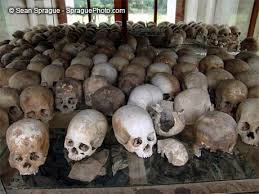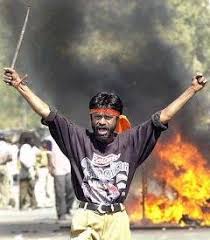‘The way anti-national elements within the country are cropping up, there is need for re-nationalisation’.
My blood curdled when I read these words, reportedly made by a prominent Goan at the ceremony in the town of Vasco-da-Gama held to purify the waters of the Arabian Sea. The sea had apparently been polluted by the presence of the Portuguese naval ship Sagres. The gentleman in question is used to a somewhat bombastic turn of phrase, and perhaps his own social location (‘upper’-caste and Hindu) blinded him to the connections that other persons not so comfortably located (‘lower’ caste and non-Hindu) make when they hear such phrases. Let us contemplate for a moment then, the analogies that could be made to similar statements from history and their contexts.
prominent Goan at the ceremony in the town of Vasco-da-Gama held to purify the waters of the Arabian Sea. The sea had apparently been polluted by the presence of the Portuguese naval ship Sagres. The gentleman in question is used to a somewhat bombastic turn of phrase, and perhaps his own social location (‘upper’-caste and Hindu) blinded him to the connections that other persons not so comfortably located (‘lower’ caste and non-Hindu) make when they hear such phrases. Let us contemplate for a moment then, the analogies that could be made to similar statements from history and their contexts.
Take as a first example the Chinese experience of the Cultural Revolution launched by Mao in his effort to regain power over Communist China. In his attempt to maintain hegemony over the country and remain in power Mao insinuated that the revolution was being infiltrated by liberal bourgeois elements that would threaten the recent successes of the communist revolution in China. In the turmoil that followed this move for power, large numbers of persons were sent for re-education. This process of ‘re-education’ included the exiling of persons to distant parts of China where they were engaged in hard labour, and publicly humiliated, submitted to torture and public lynching, sometimes killed. The Cultural Revolution was an unsafe period in China where persons who were skilled above the average were targeted by the mob, where personal vendettas were carried out justified by the ideological language of the revolution, and where minority groups were forced into assimilation programs. Thousands were killed, maimed or their life-chances destroyed as a result of the Cultural Revolution that insisted, as was insisted in Vasco, that there was a threat to the country and a need for re-education.
country and remain in power Mao insinuated that the revolution was being infiltrated by liberal bourgeois elements that would threaten the recent successes of the communist revolution in China. In the turmoil that followed this move for power, large numbers of persons were sent for re-education. This process of ‘re-education’ included the exiling of persons to distant parts of China where they were engaged in hard labour, and publicly humiliated, submitted to torture and public lynching, sometimes killed. The Cultural Revolution was an unsafe period in China where persons who were skilled above the average were targeted by the mob, where personal vendettas were carried out justified by the ideological language of the revolution, and where minority groups were forced into assimilation programs. Thousands were killed, maimed or their life-chances destroyed as a result of the Cultural Revolution that insisted, as was insisted in Vasco, that there was a threat to the country and a need for re-education.
A second example, once more from Asia is that of the Khmer Rouge. Originally inspired by communism, the Khmer Rouge sought to create a nationally appropriate form of the ideology for Cambodia and create an agrarian utopia. The result of this was a project of social engineering which unfortunately, and not unsurprisingly, turned into one of the worst genocides in human history. About two million Cambodians are estimated to have died in the in waves of murder, torture, and starvation, aimed particularly at the educated and intellectual elite, but included other groups – including ethnic and religious minorities - as well. As was suggested in Vasco, re-education was attempted by the Khmer regime, that like in China subjected persons deemed to be against the regime, to hard labour, humiliation, torture and death.
Originally inspired by communism, the Khmer Rouge sought to create a nationally appropriate form of the ideology for Cambodia and create an agrarian utopia. The result of this was a project of social engineering which unfortunately, and not unsurprisingly, turned into one of the worst genocides in human history. About two million Cambodians are estimated to have died in the in waves of murder, torture, and starvation, aimed particularly at the educated and intellectual elite, but included other groups – including ethnic and religious minorities - as well. As was suggested in Vasco, re-education was attempted by the Khmer regime, that like in China subjected persons deemed to be against the regime, to hard labour, humiliation, torture and death.
The Cultural Revolution and the regime of the Khmer Rouge are just two of the horrific examples from Asia. In both cases dominant groups within the country subjected vast numbers of innocent persons to torture and death for failing to meet the national ideal as articulated by these groups. These groups were those groups that could not, according to the logic of the dominant, be re-educated. All horrific experiments like the two presented for contemplation begin with innocent ideas and grandiose statements like those made in the town of Vasco-da-Gama. It is for this reason that we should not brush this episode under the carpet but take it very seriously indeed.
India is no stranger to experiences like those in China or Cambodia. The Muslim populations of India have been subject to such experiments as well. One does not have to look far, but only toward the experience of Gujarat, where Gujarati Muslims were demonized over a long period of time. As a result when the proper environment was created it was possible to kill them in the thousands since they were no longer seen as human beings, but as enemies of the State and society. We all know of the days in the early 80’s and before when Muslims were seen as being unpatriotic for allegedly celebrating when Pakistan won cricket matches. How innocent that Indian nationalist annoyance seems today when compared with the violent killing of Muslims that took place in Gujarat in 2002.
The Muslim populations of India have been subject to such experiments as well. One does not have to look far, but only toward the experience of Gujarat, where Gujarati Muslims were demonized over a long period of time. As a result when the proper environment was created it was possible to kill them in the thousands since they were no longer seen as human beings, but as enemies of the State and society. We all know of the days in the early 80’s and before when Muslims were seen as being unpatriotic for allegedly celebrating when Pakistan won cricket matches. How innocent that Indian nationalist annoyance seems today when compared with the violent killing of Muslims that took place in Gujarat in 2002.
The statement made in Vasco-da-Gama belongs to the kind of imagination that converted Modi’s Gujarat, Mao’s China and the Khmer Rouge’s Cambodia into a horrific examples of human savagery. What was scary about the sea-purification episode in Vasco-da-Gama was that it targeted not only the Portuguese, but local Goan Catholics as well. It put the Goan Catholic who may culturally identify with some aspects Portuguese, on the same level as the Kashmiri who demands Azaadi, or the Indian Muslim who is deemed to be rooting for Pakistan. This is a matter of concern that we should not take lightly. It is only a troubling portent of darker times to come.
My blood curdled when I read these words, reportedly made by a
Take as a first example the Chinese experience of the Cultural Revolution launched by Mao in his effort to regain power over Communist China. In his attempt to maintain hegemony over the
A second example, once more from Asia is that of the Khmer Rouge.
The Cultural Revolution and the regime of the Khmer Rouge are just two of the horrific examples from Asia. In both cases dominant groups within the country subjected vast numbers of innocent persons to torture and death for failing to meet the national ideal as articulated by these groups. These groups were those groups that could not, according to the logic of the dominant, be re-educated. All horrific experiments like the two presented for contemplation begin with innocent ideas and grandiose statements like those made in the town of Vasco-da-Gama. It is for this reason that we should not brush this episode under the carpet but take it very seriously indeed.
India is no stranger to experiences like those in China or Cambodia.
The statement made in Vasco-da-Gama belongs to the kind of imagination that converted Modi’s Gujarat, Mao’s China and the Khmer Rouge’s Cambodia into a horrific examples of human savagery. What was scary about the sea-purification episode in Vasco-da-Gama was that it targeted not only the Portuguese, but local Goan Catholics as well. It put the Goan Catholic who may culturally identify with some aspects Portuguese, on the same level as the Kashmiri who demands Azaadi, or the Indian Muslim who is deemed to be rooting for Pakistan. This is a matter of concern that we should not take lightly. It is only a troubling portent of darker times to come.
(A version of this blog entry was first published in the Gomantak Times 29 Dec 2010)

No comments:
Post a Comment